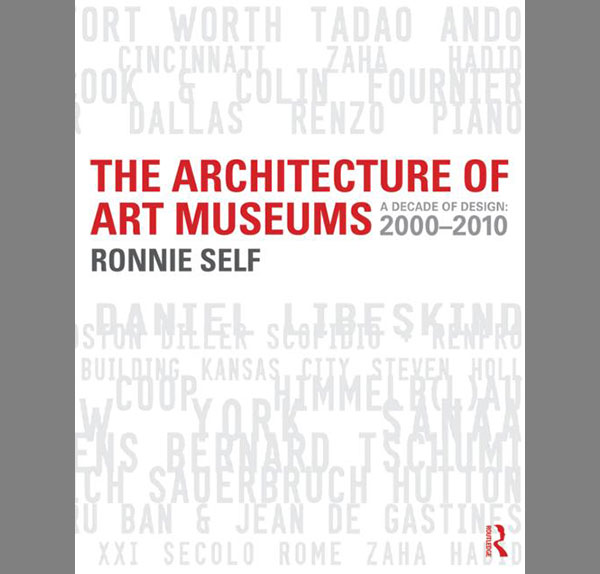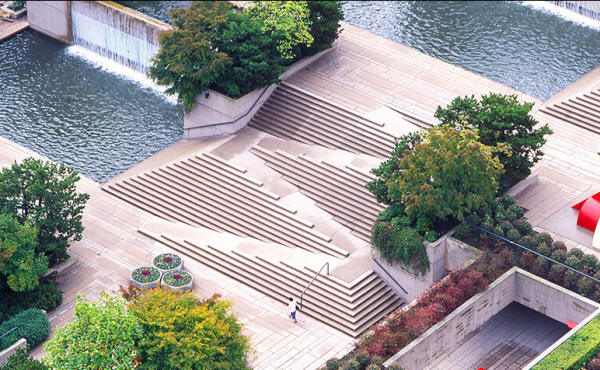
As a building type, art museums are unparalleled for the opportunities they provide for architectural investigation and experimentation. They are frequently key components of urban revitalization and often push the limits of building technology. Art museums are places of pleasure, education, and contemplation. They are remarkable by their prominence and sheer quality, and their lessons are useful for all architects and for all building types.
– From the Foreword
Written by Ronnie Self, (Routledge Press, 2014)
In Ronnie Self’s new book on this typology of the spectacle, The Architecture of Art Museums presents eighteen of the most formidable galleries realized in the last fourteen years. The book includes two each by Herzog & de Meuron, SANAA and Zaha Hadid, all presented in plan, elevation, and section, several even with construction details. With a brief essay and colour photographs for every project, standouts include the Akron Art Museum by Coop Himmelb(l)au and Acropolis Museum by Bernard Tschumi. And so with Vancouver soon to be home to a new gallery of the highest order, Mr. Self’s book is the perfect primer on the subject for both neophyte and admirer alike.
As explained by the author in the introduction, the majority of the book is comprised of articles written for the French magazine Archicree between 2000 and 2010, the majority of which just happened to be on art museums as the magazine was writing on the leading works of the day.
The book reads chronologically then, with museums by Tadao Ando, Zaha Hadid, and Peter Cook starting things off and effectively introducing us to the spectrum of the typology. The differences between them set the tone for the discussion in the pages that follow.
Starting with Ando’s stoic and restrained Modern Art Museum in Fort Worth, we look next at the wolf in sheep’s clothing that is Hadid’s Cincinnati art gallery, followed by the hallucinatory, Archigram-induced revelry that is the Kunsthaus Graf – a building whose extroverted exterior threatens to outdo the art within. As the author points out about Ando’s building, with Louis Kahn’s Kimbell Art Museum directly across the street (one of the earliest and best examples of the building type at its time in America), anyone visiting his contemplative gallery with its signature bare concrete walls and vast reflecting pool would almost certainly have already stood beneath Kahn’s barrel vaults.
The next three galleries are examples of the utilitarian art gallery – following Mies’ credo that form follows function – and each ultimately presents a pragmatic face to their host cities, as thoughtful material solutions to their inwardly complex programs. Such can be seen in Renzo Piano’s elaborate roof screens in his Nasher Center in Dallas, while the drawing sections of the gallery invoke his Centre Pompidou in Paris.
Taniguchi’s renovation of the MoMA is just as much a statement on the institution of modern art museums as it is an architectural achievement. Similarly, many of the buildings throughout the book are the result of art gallery societies needing a modern re-branding of their legacy, with the MoMA’s facelift in 2004 very much emblematic of this spirit.
The next chapter on Herzog and de Meuron’s Walker Center includes a discussion on the same building’s original architect, Edward Larrabee Barnes, known for several art museums he designed across America. The architect met Herzog and de Meuron when they were shortlisted as architects for the MoMA expansion, which Taniguchi won. Similarly, as Barnes was on the jury for the MoMA in New York, he was on the selection committee in San Francisco that chose Herzog and de Meuron for the de Young Museum. It was not long after that when they were asked to design a significant addition to the Walker gallery, which Barnes himself originally designed in 1971.
The following three art museums look at the gallery as an object in the city, with each building making an outward statement as well as providing an important centre for housing its art. In the case of these three galleries by Jean Nouvel, Herzog and de Meuron, and SANAA, the architects have given their host cities – Madrid, San Francisco, and Toledo, respectively – an art museum in which the building itself has become a part of the collection.
Even more, the architecture is allowed to play a part in the restoration of some past misfortune, as Nouvel’s addition to the Reina Sofia Madrid museum provided for the institution which had brought Picasso’s Guernica to the city post-Franco in 1992. Similarly, Herzog and de Meuron’s new building replaced the de Young’s original building, badly damaged in the Loma Prieta earthquake in 1989 (the gallery’s tower is a reference to the tower in the original building).
The Toledo Glass Museum, designed by the Pritzker winning office SANAA, is the evolution of the art museum to a sublime fun-house, as what appears as a box-like glass building on the outside is an amorphous sequence of spaces within. With delicious curving glass walls, the exercise is one in making the obvious disappear – joint, mullions and all – with the author including some of the architectural window wall details. SANAA and their exquisite attention to detail is also evident in their New York gallery, featured later on in the book.
Chapters ten through to thirteen demonstrate architecture’s ability to challenge the physics of the building form, as the gravity defying expressions of Coop Himmelb(l)au, Diller Scofidio + Renfro, and Daniel Libeskind attest to. In Denver, Studio Libeskind gave the city an inverted and fractured glass prism, the result of a competition whose shortlist included Steven Holl and Robert Venturi.
In Akron, Ohio, another design competition – this one with over 130 entries – yielded Coop Himmelb(l)au’s solution to a complex site and program, tying together existing buildings, including the city’s old post office, with a new gallery building, all covered in a massive cantilevered structure called the Roof Cloud.
Steven Holl’s Kansas City gallery distinguishes itself from these other gravity defying acts of architecture by appealing more to the diurnal aspect of architecture, with the galleries appearing in the nightscape as magically glowing volumes. This phenomenological aspect of architecture is a recurring theme in Holl’s work, and so it is no surprise to see it as the driver of his design.
The remainder of the book is rounded out by some of architecture’s recent heavyweights: SANAA’s New Museum in New York, Bernard Tschumi’s Acropolis Museum, and Zaha Hadid’s MAXXI Museum. Zaha mentions at one point that several of the competitions for most of the museums in the book were happening concurrently, that she herself was working on the MAXXI competition at the same time she was working on the Madrid one (that went to Nouvel) along with the Kunsthaus (that went to Peter Cook).
In the end, the book effectively demonstrates the importance of this particular building type for the stretching of one’s architectural legs. History also shows us some of the most innovative solutions to the typology, also equally as controversial, such as Frank Lloyd Wright’s spiral for his Guggenheim in New York, Rogers and Piano’s Pompidou in Paris, and Gehry’s cacophonous spectacle of titanium in Bilbao.
Indeed, many of the galleries featured in the book are art institutions seeking the same success as Bilbao, each city looking to reinvent part of its urban fabric with a new stand-alone art museum. As well, there are also a number of galleries featured here that are additions to existing galleries, while other are new buildings being inserted into a dense urban fabric – such as the MAXXI, Kuntshaus, and MoMA – providing insight into how to navigate a tight inner city site with a complex building program.
These and many more lessons on this building typology make the Architecture of Art Museums – A Decade of Design a valuable addition to one’s architecture tool belt, and serendipitous as Metro Vancouver is poised to realize a new stand-alone art museum for the heart of its downtown.
***
For more information on Architecture of Art Museums – A Decade of Design, visit the Routledge website.
**
Sean Ruthen is a Vancouver-based architect and writer.


